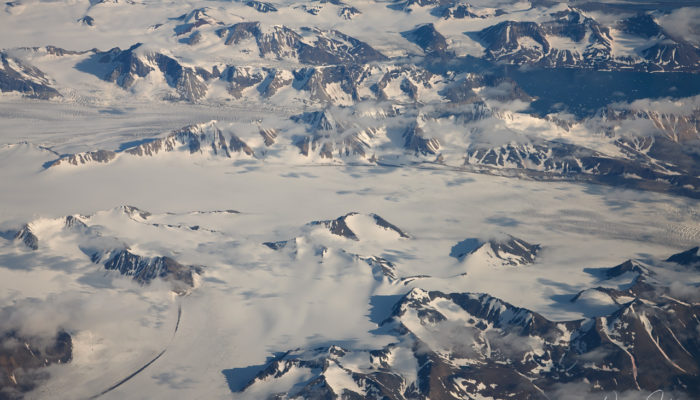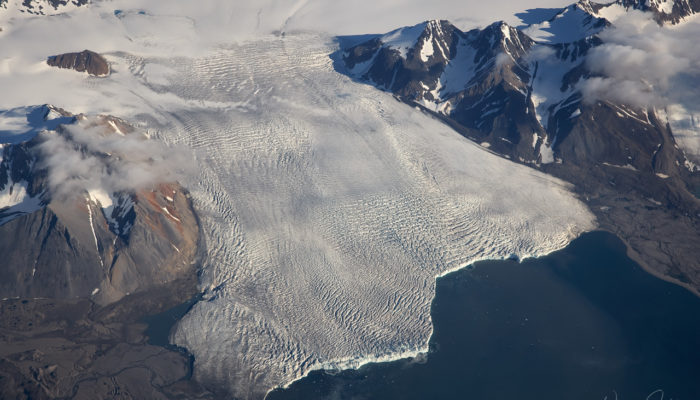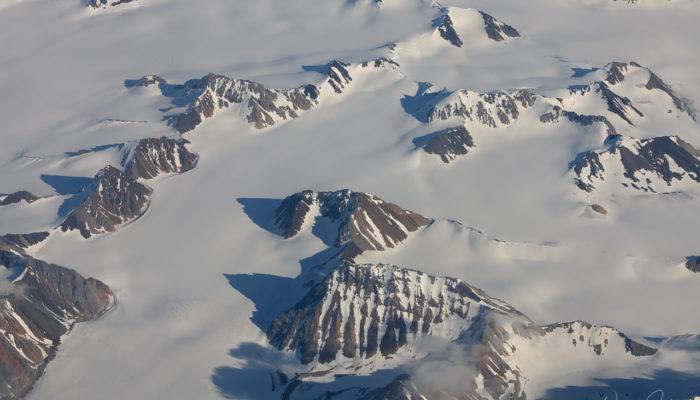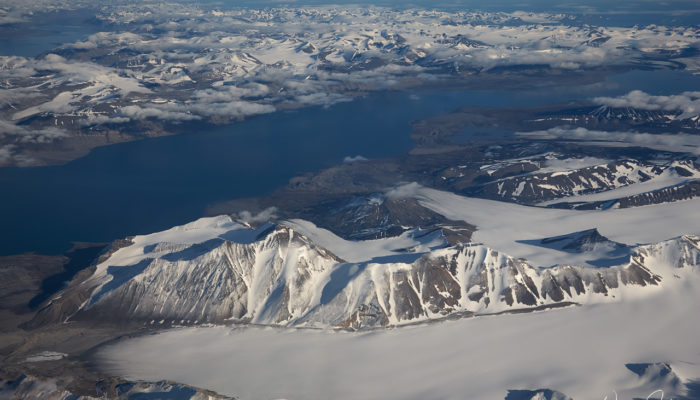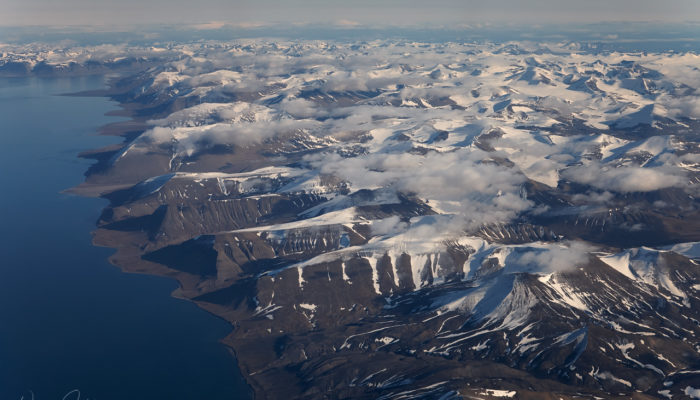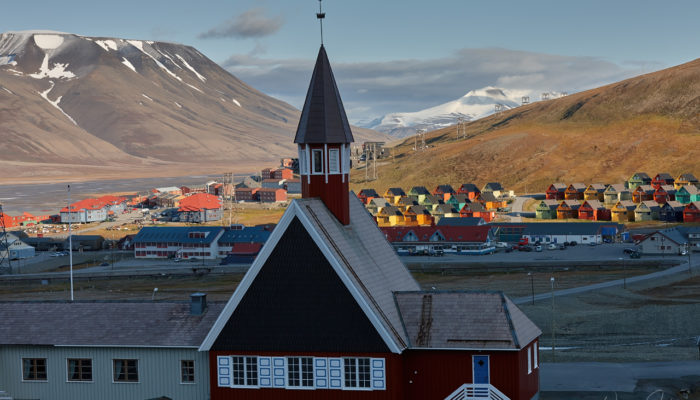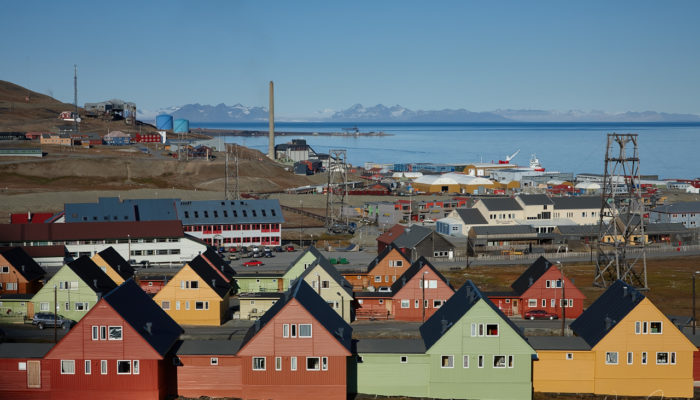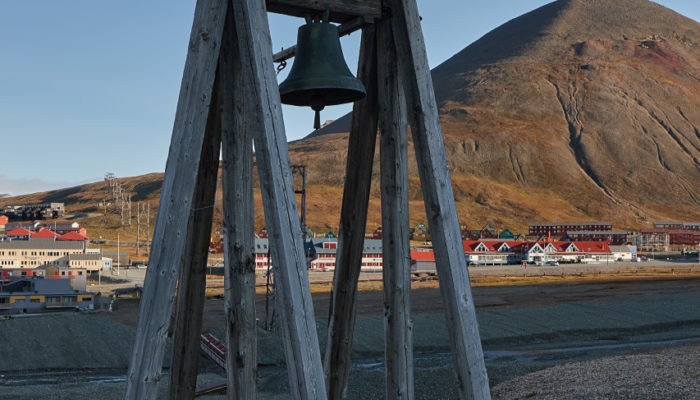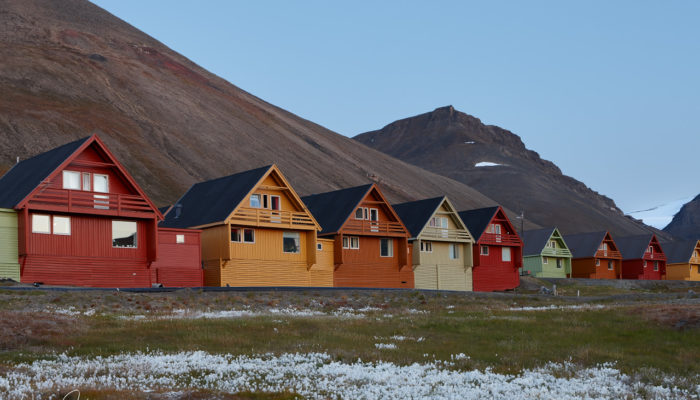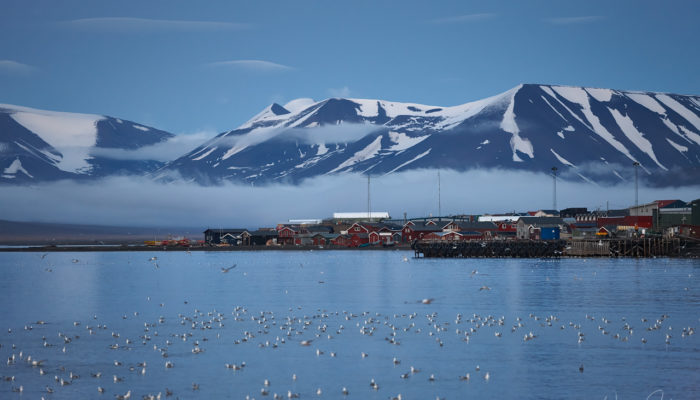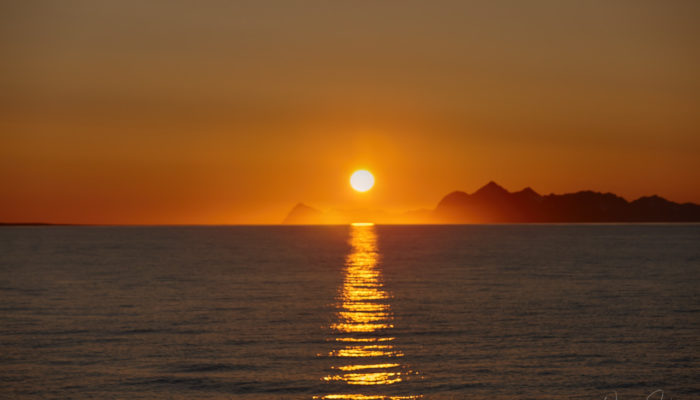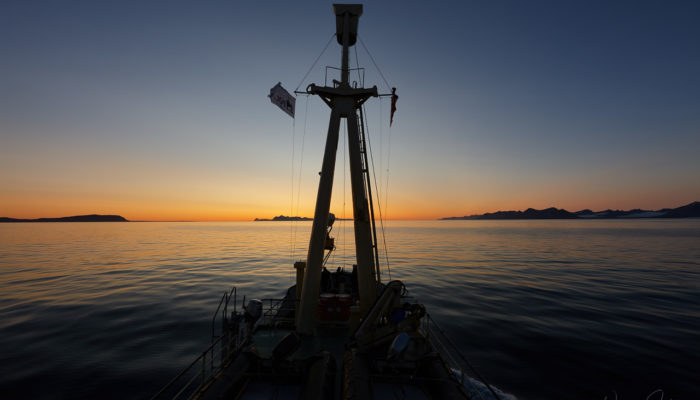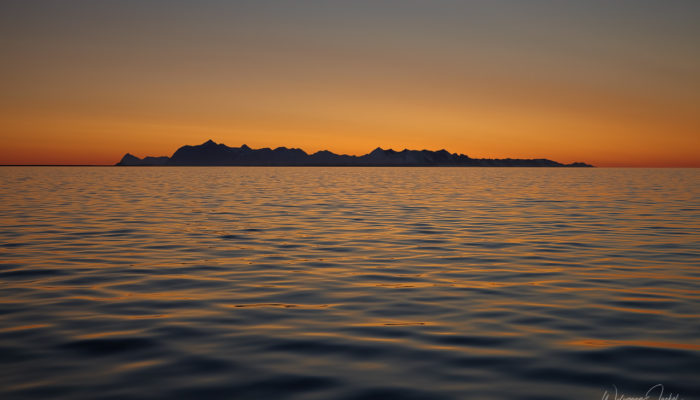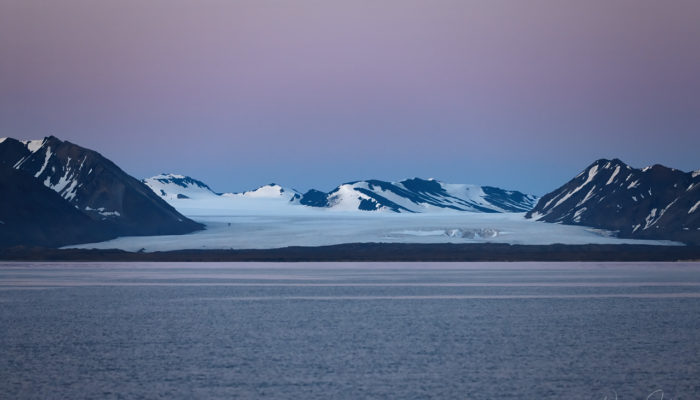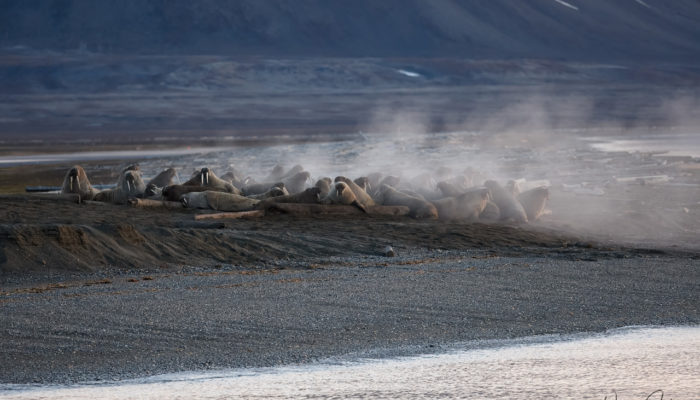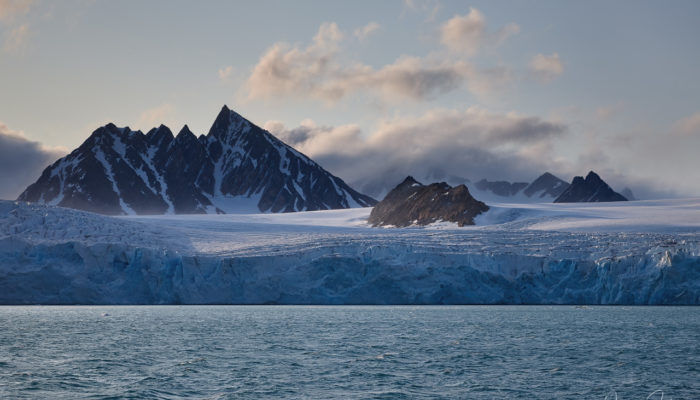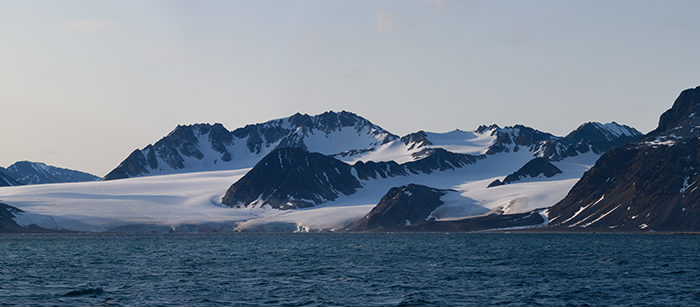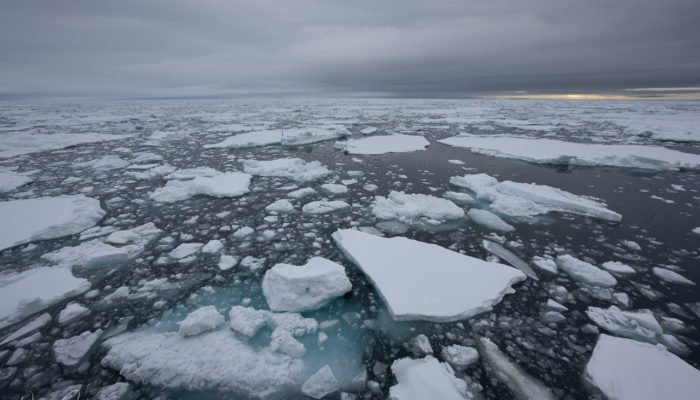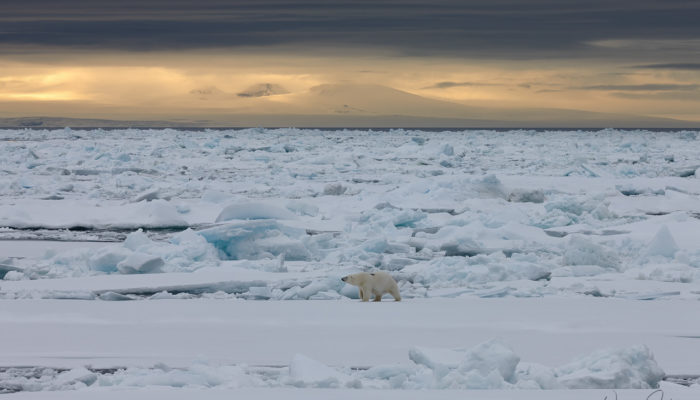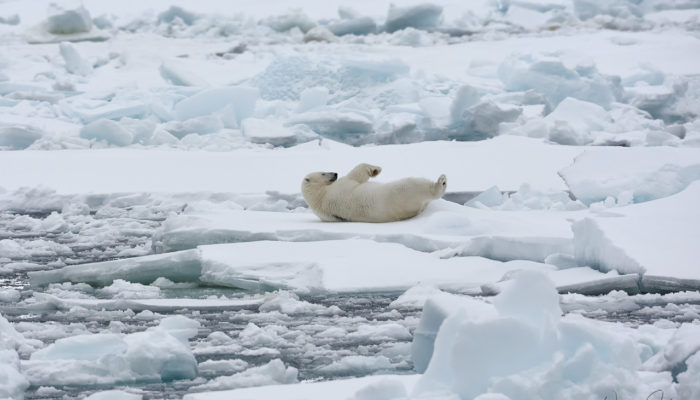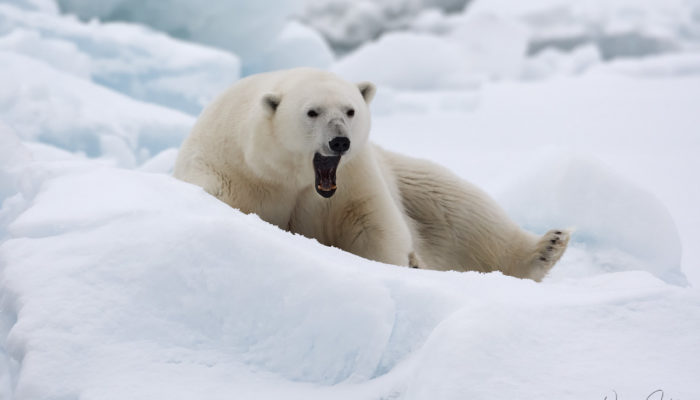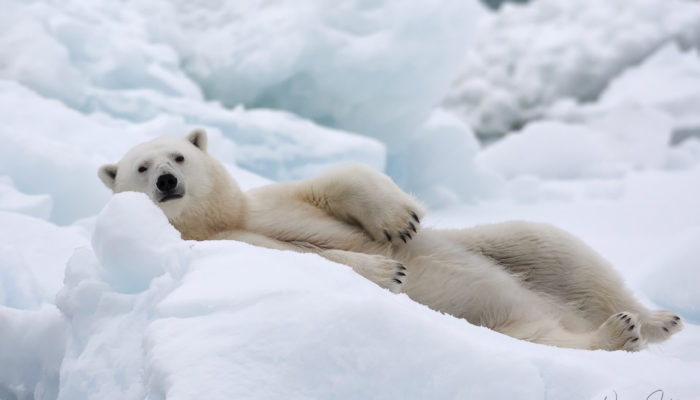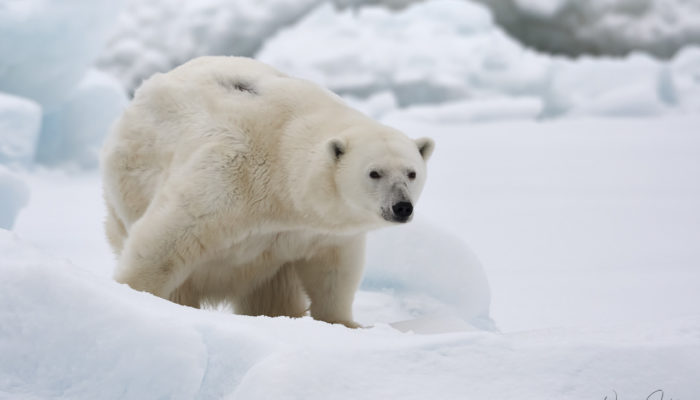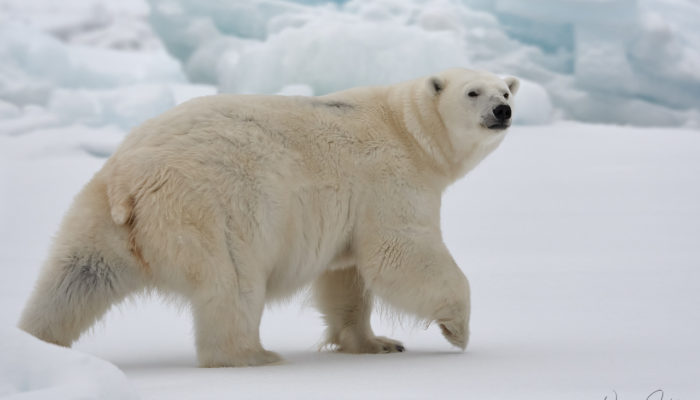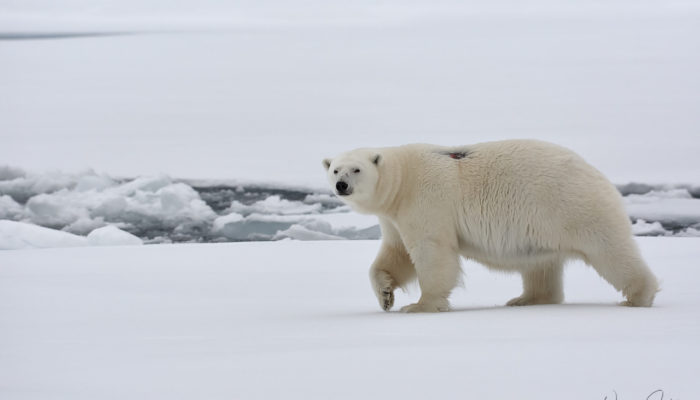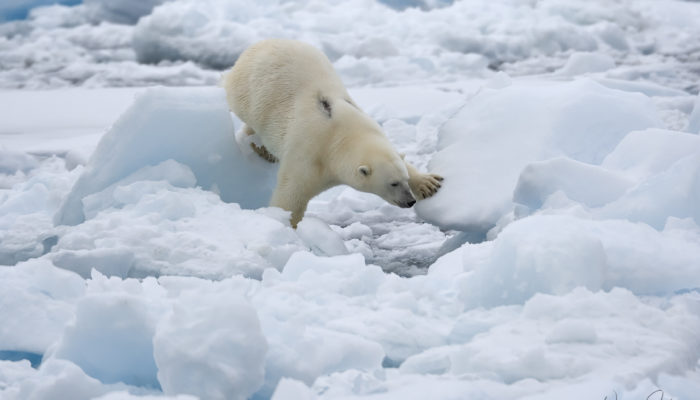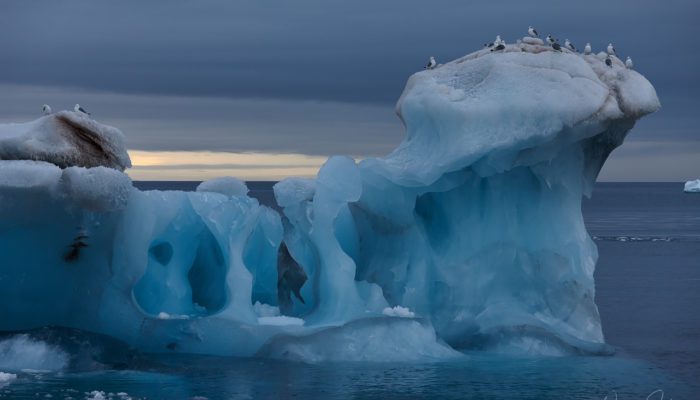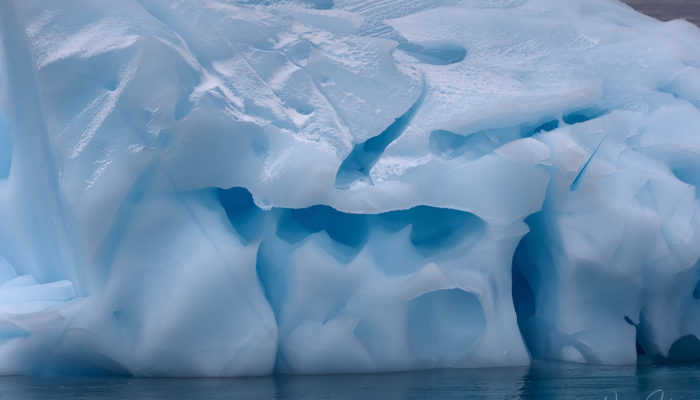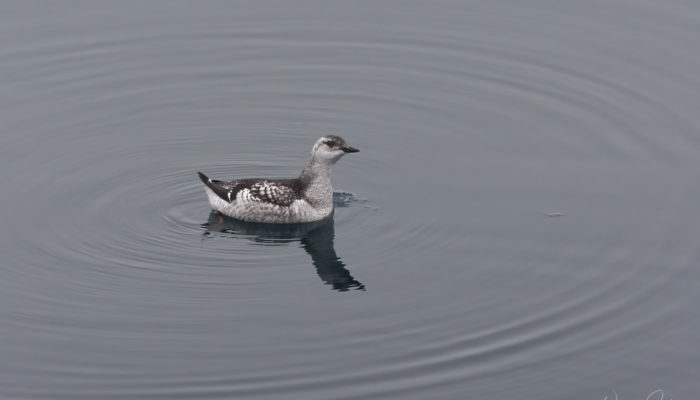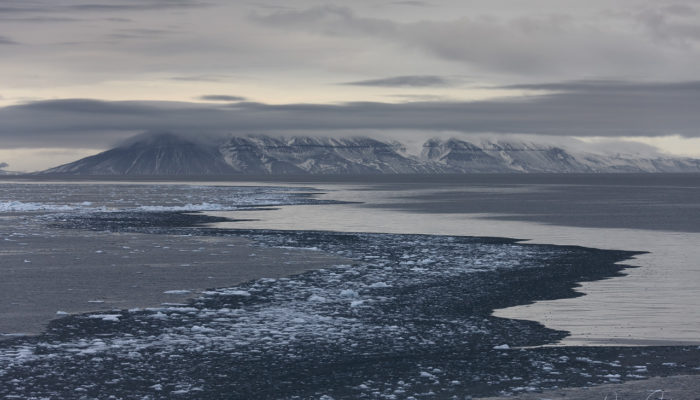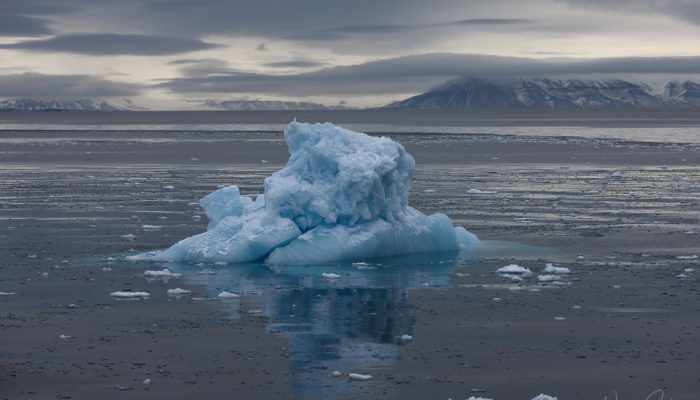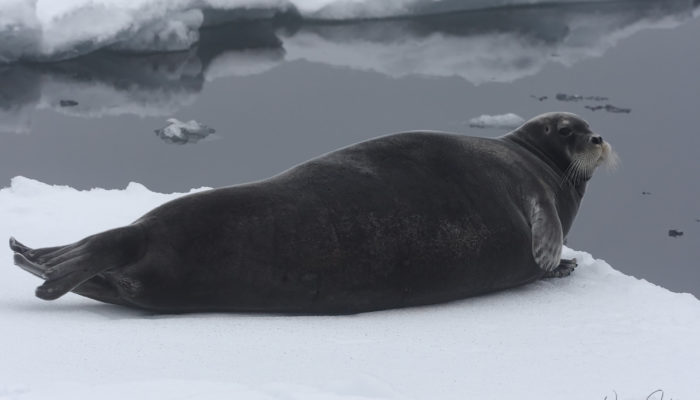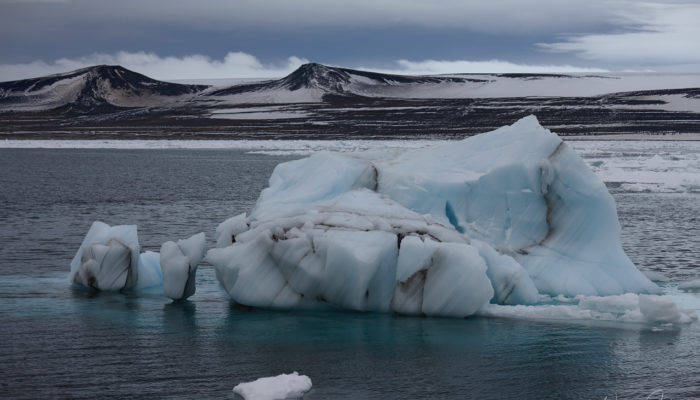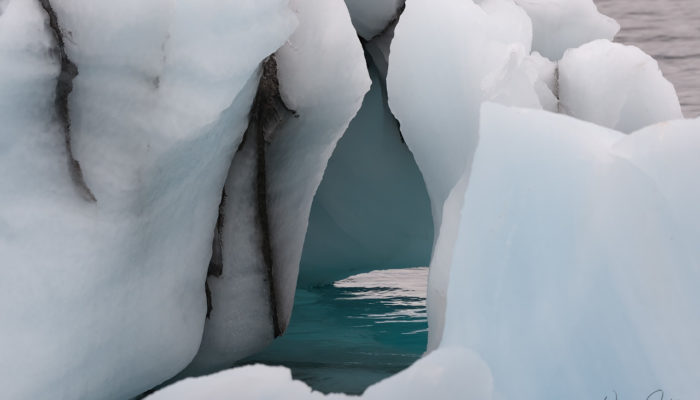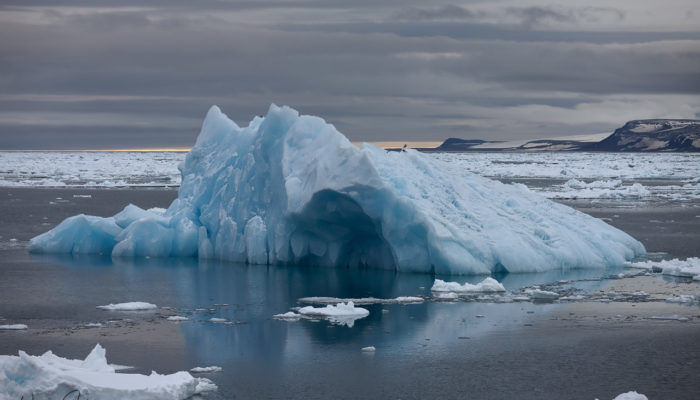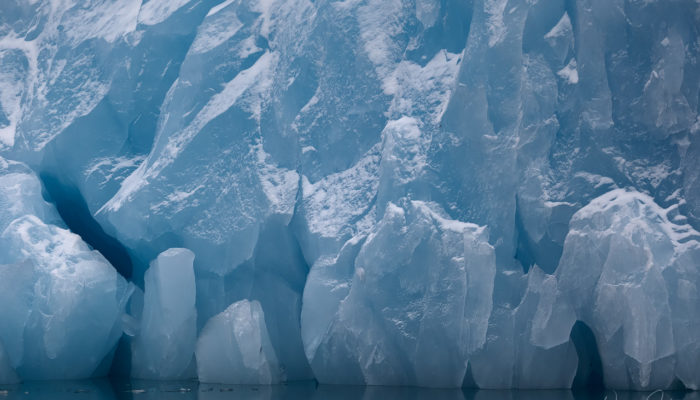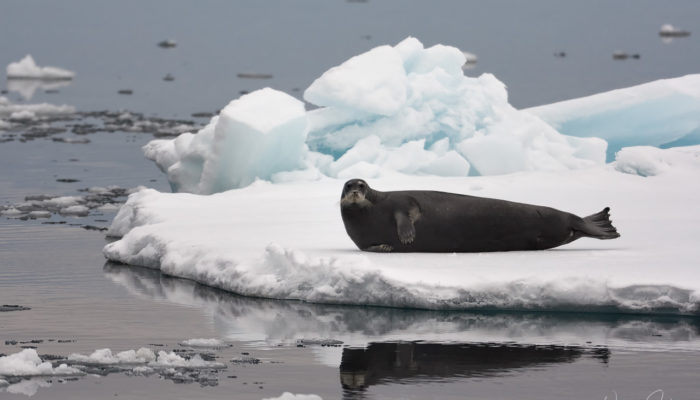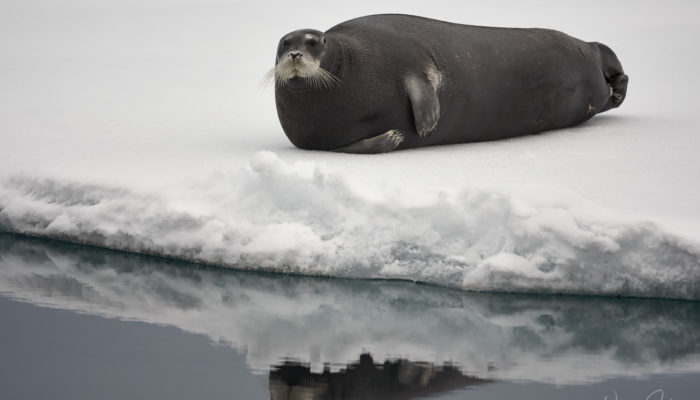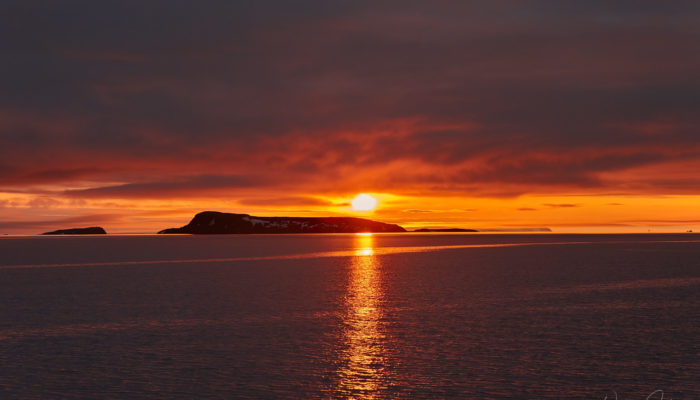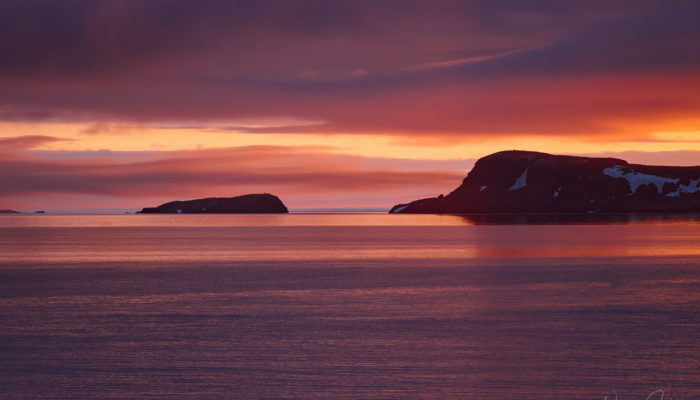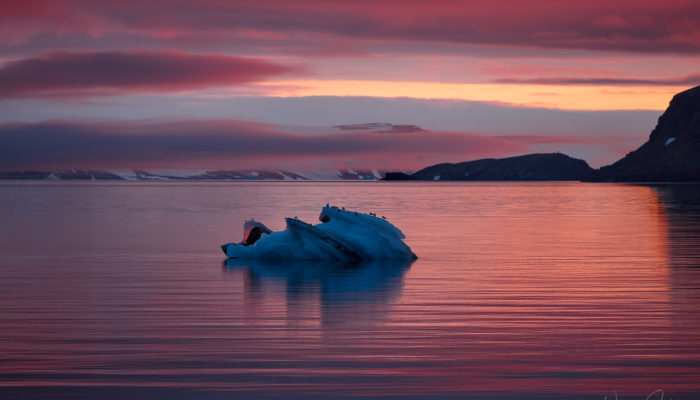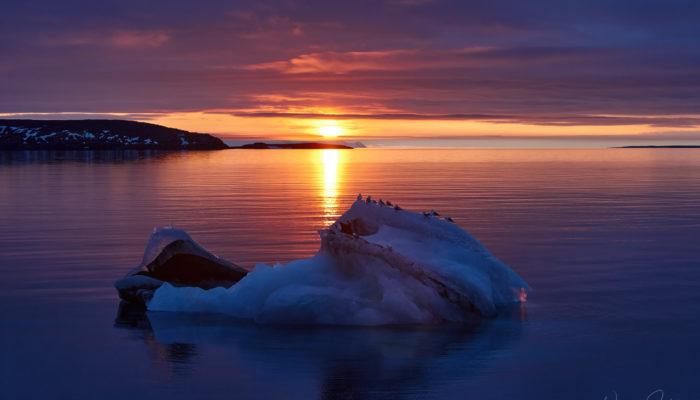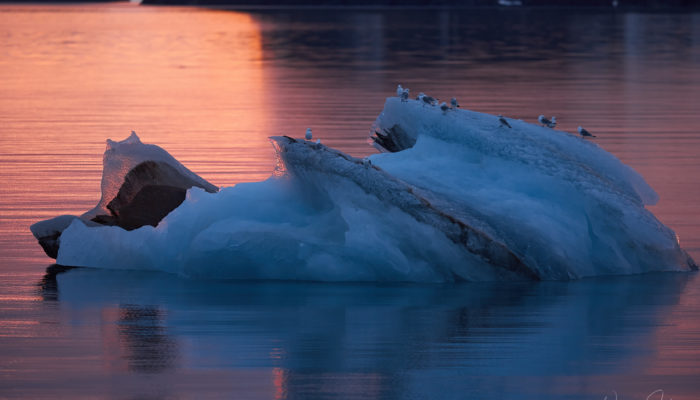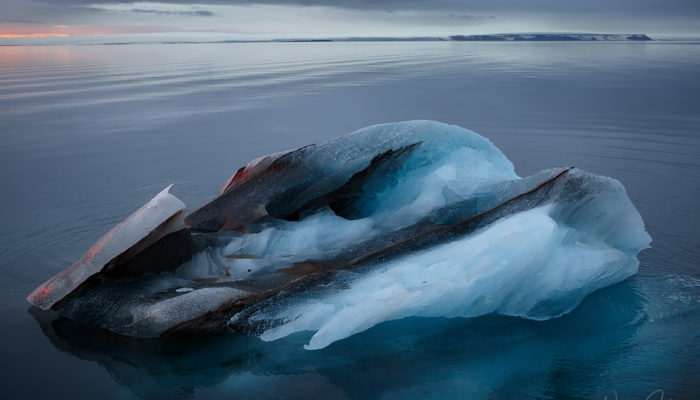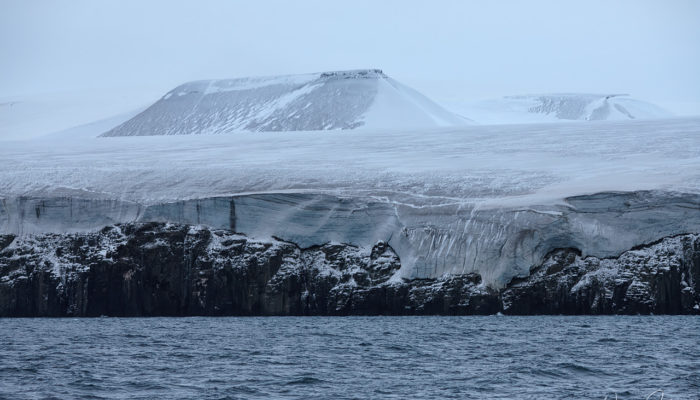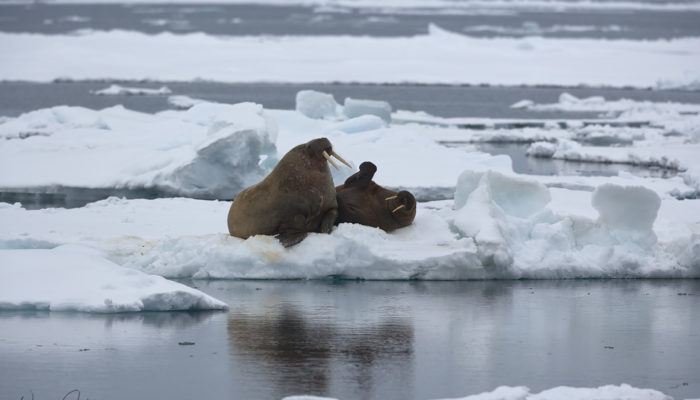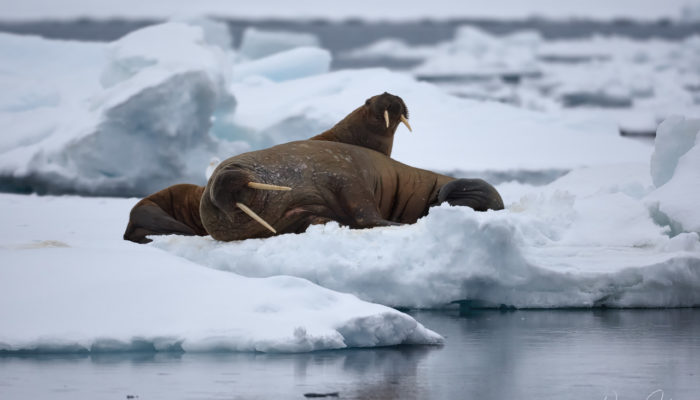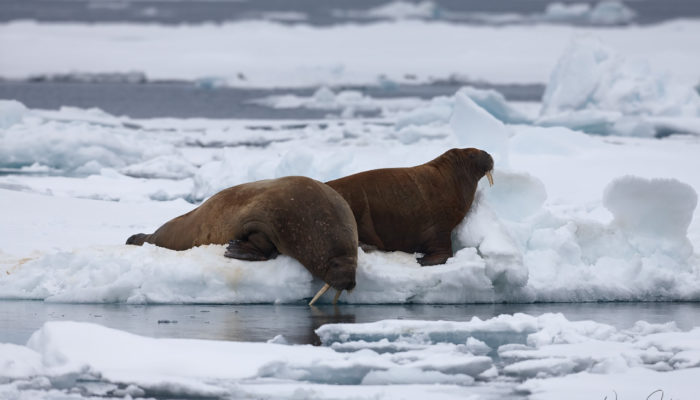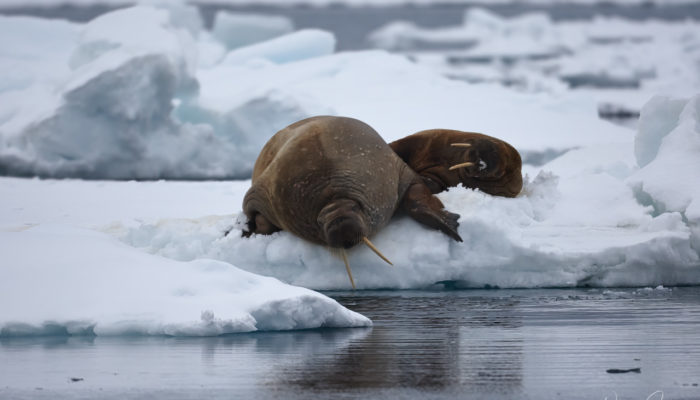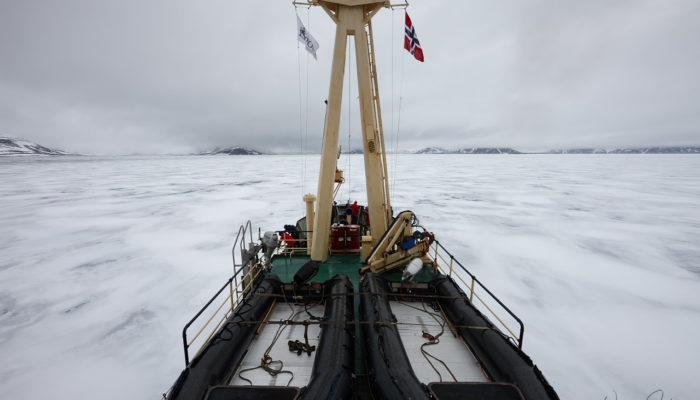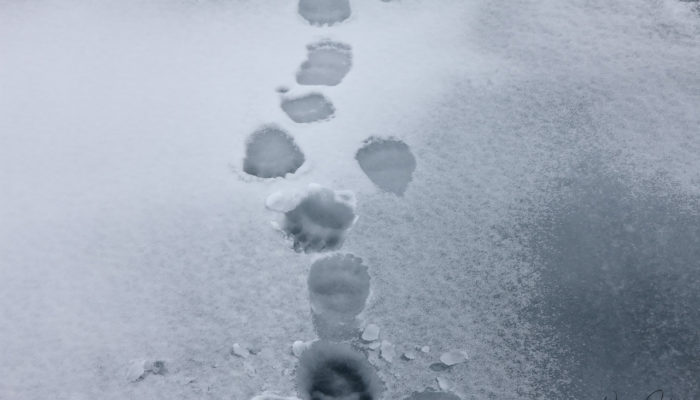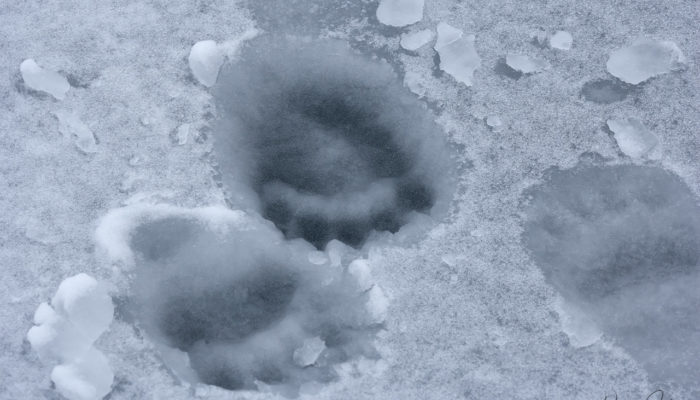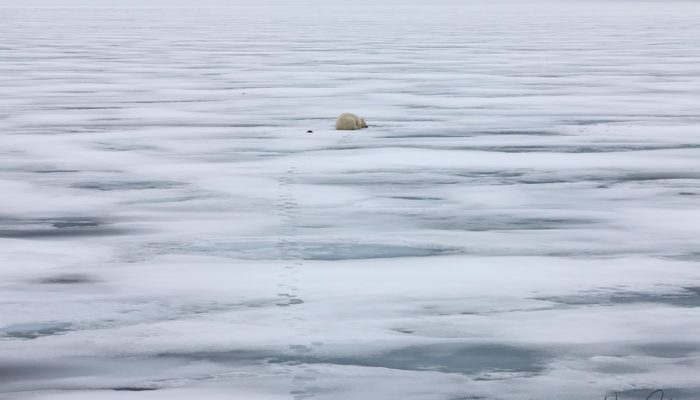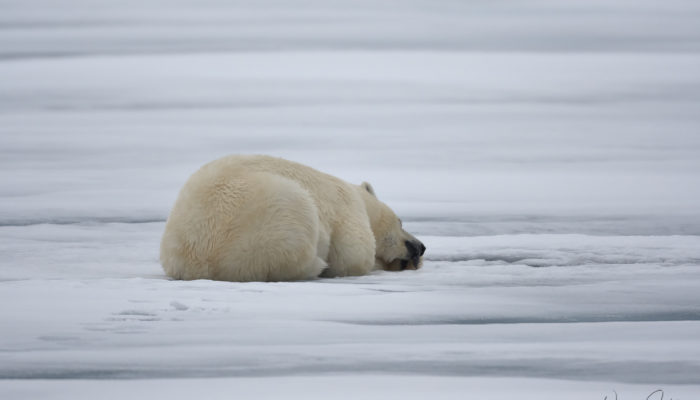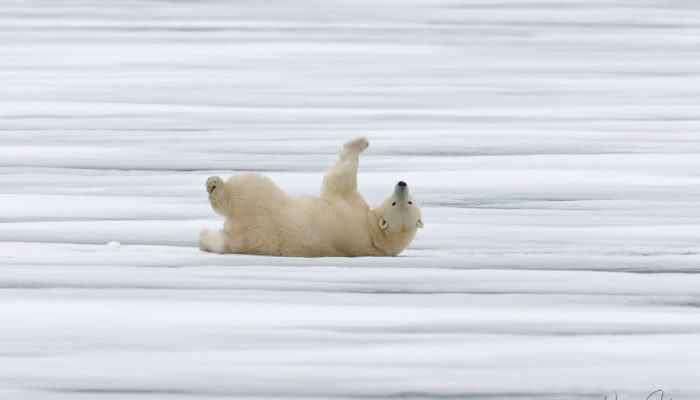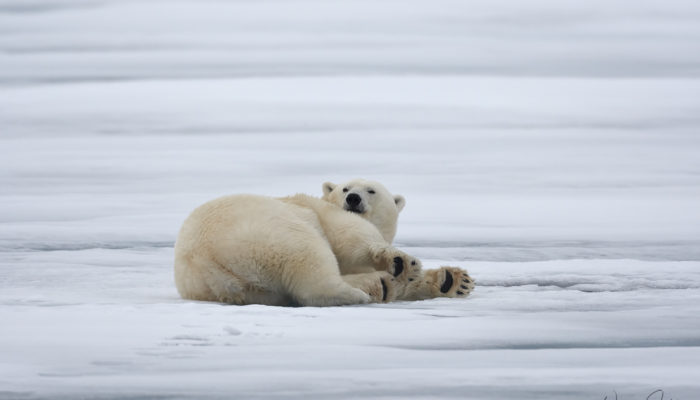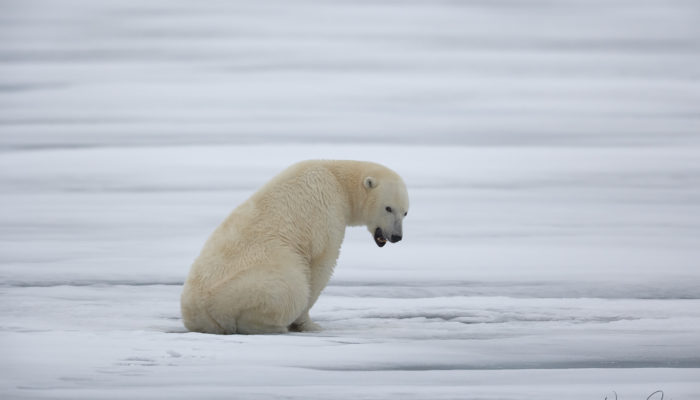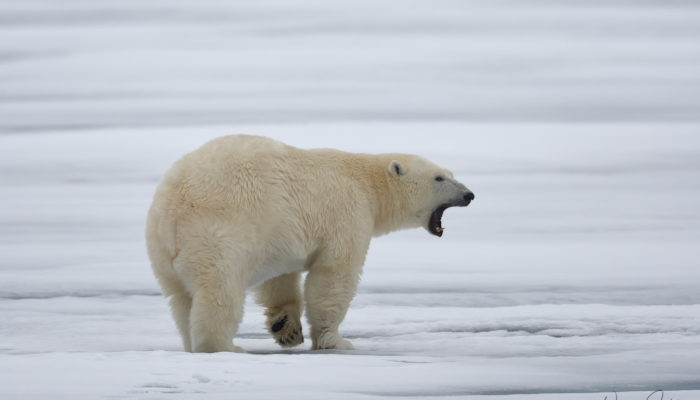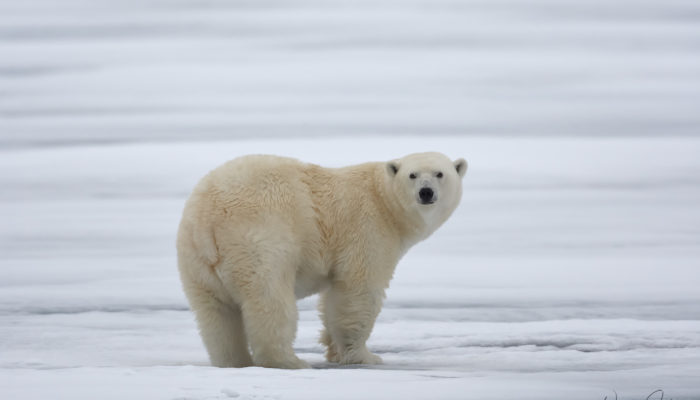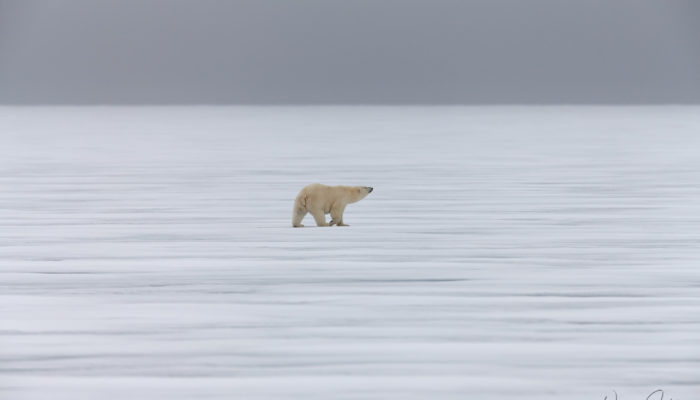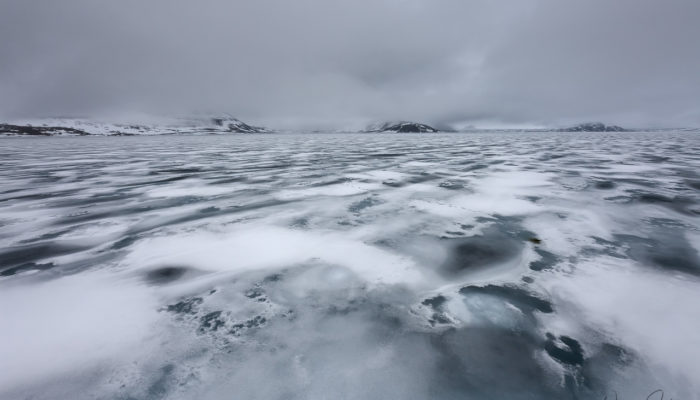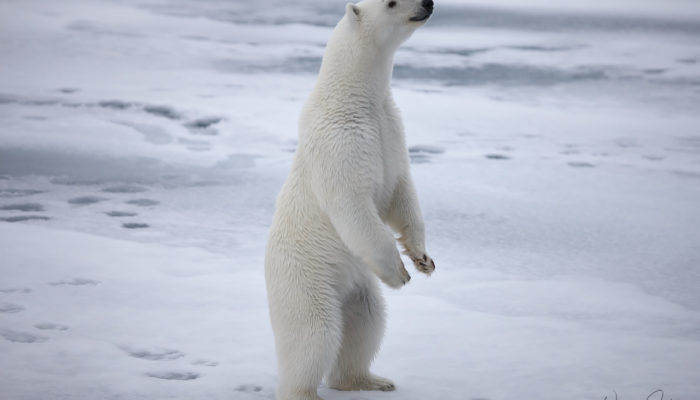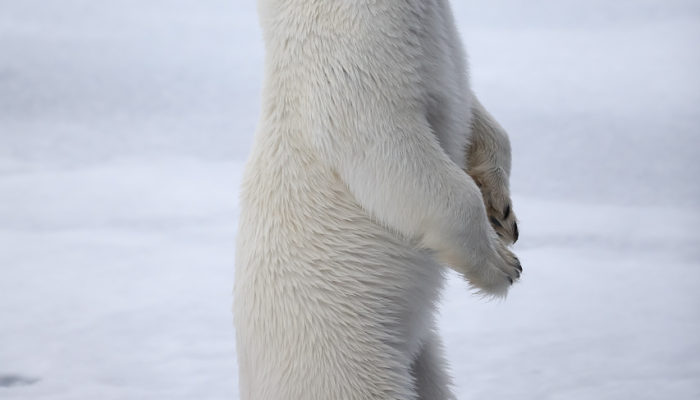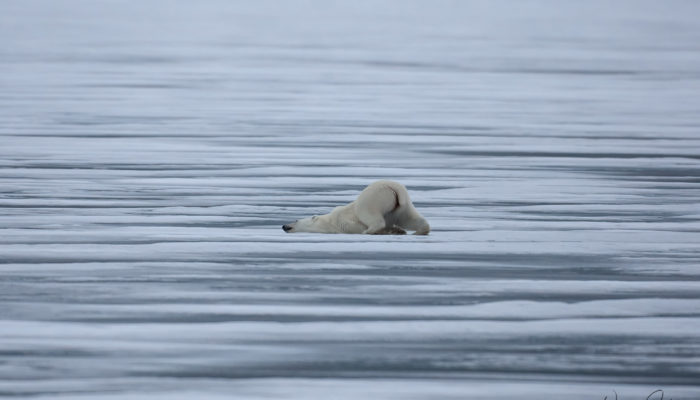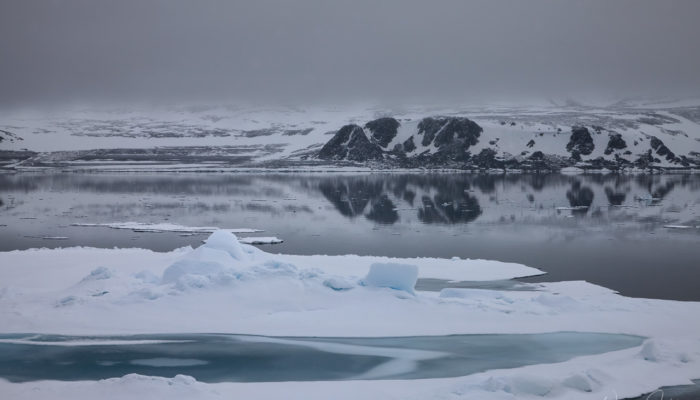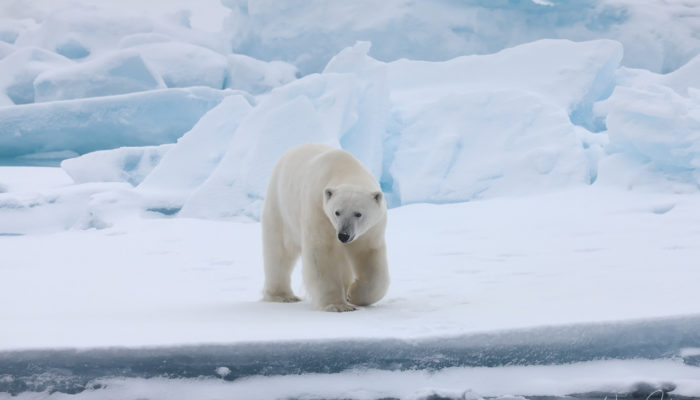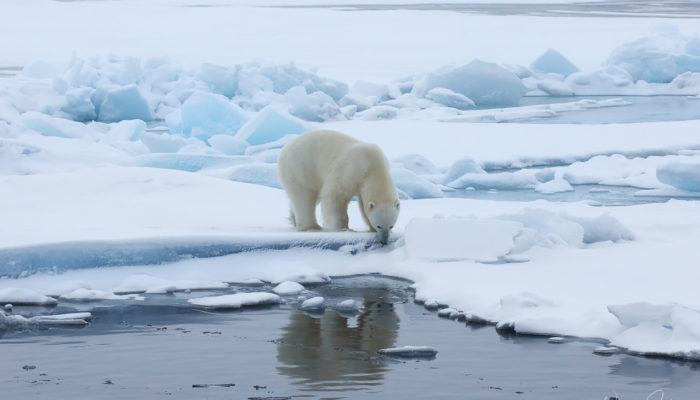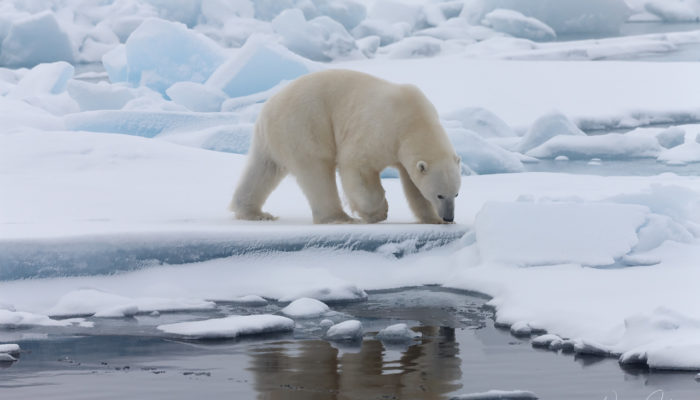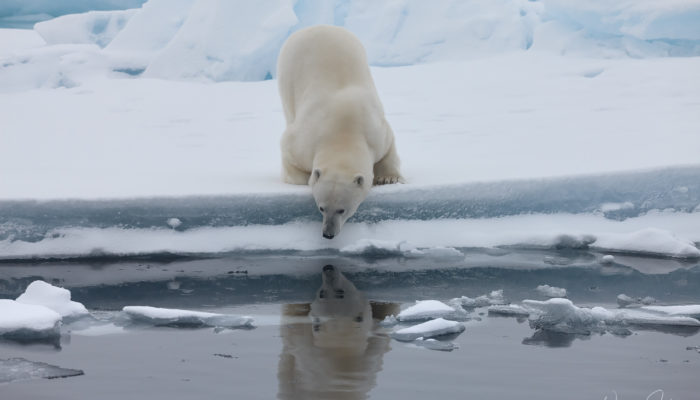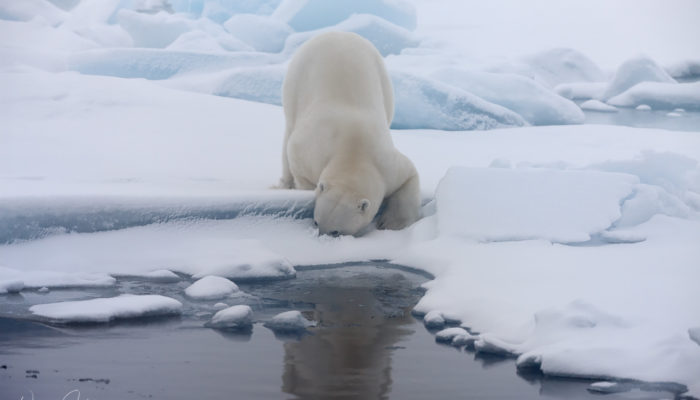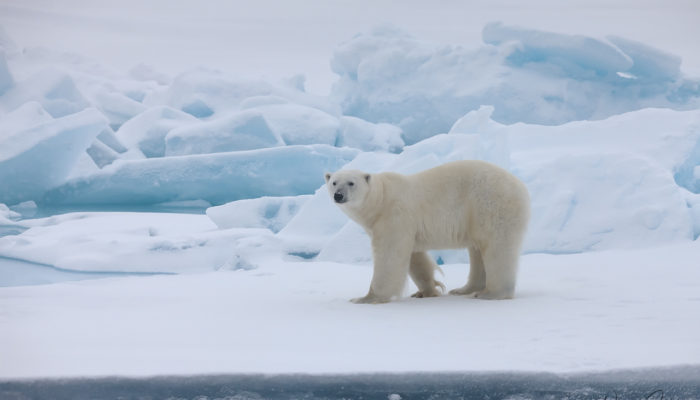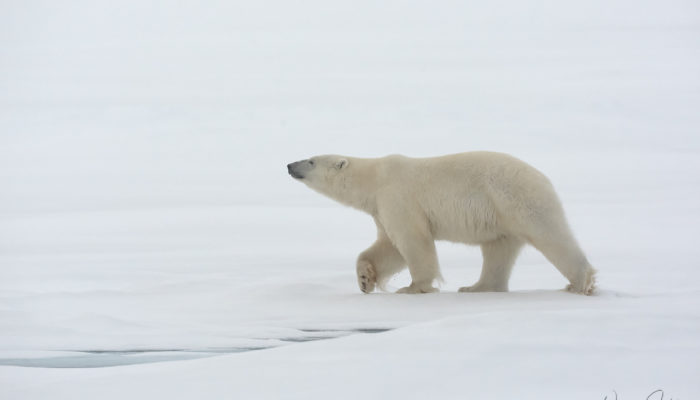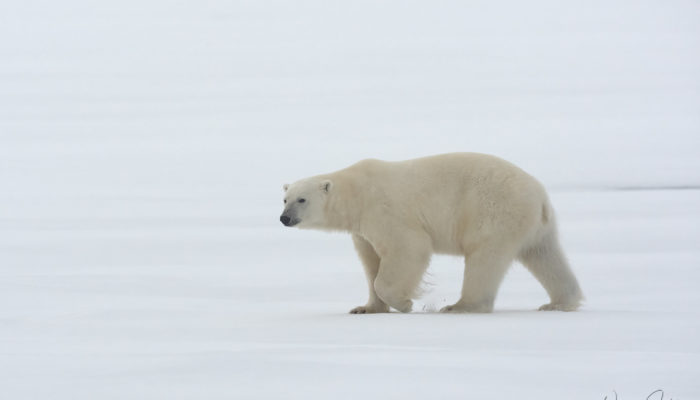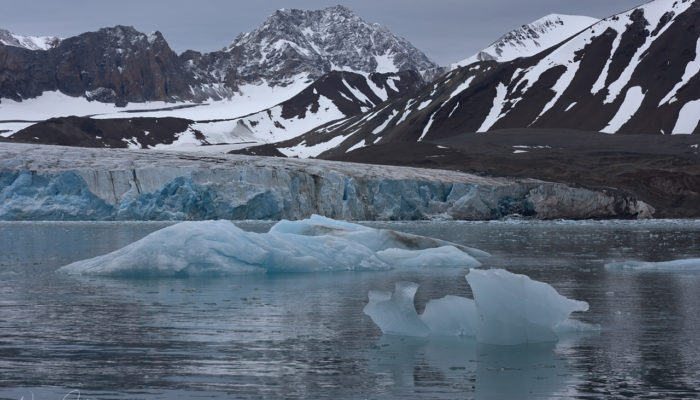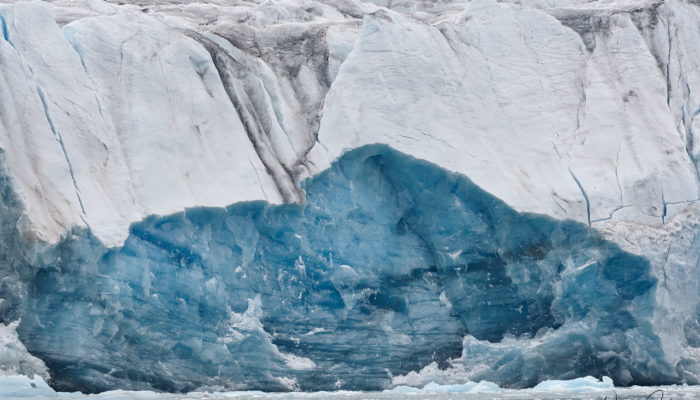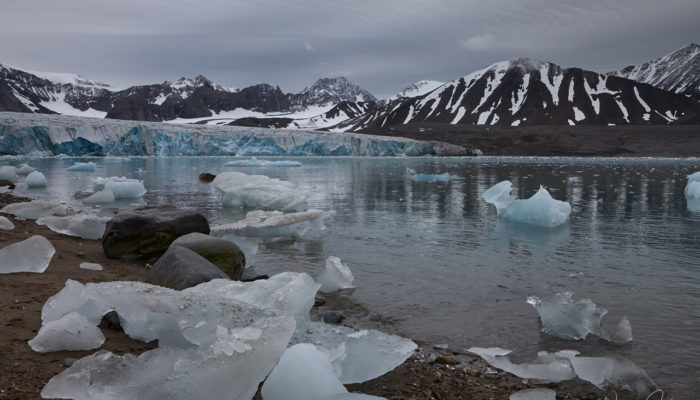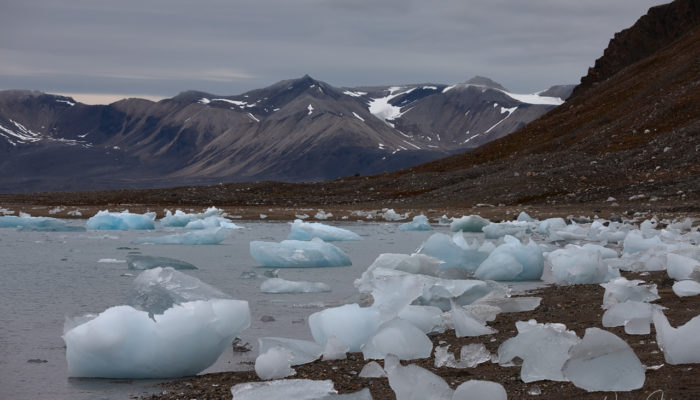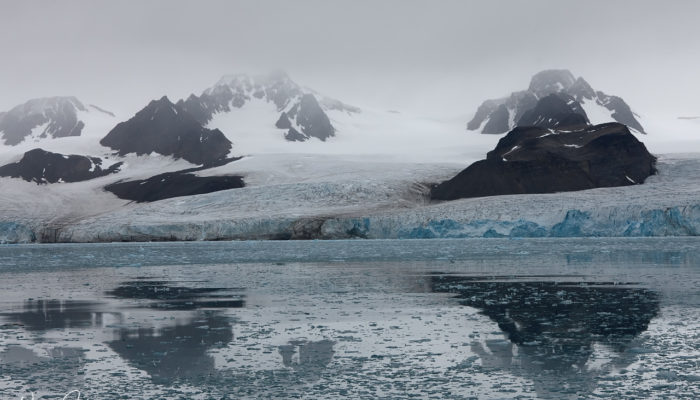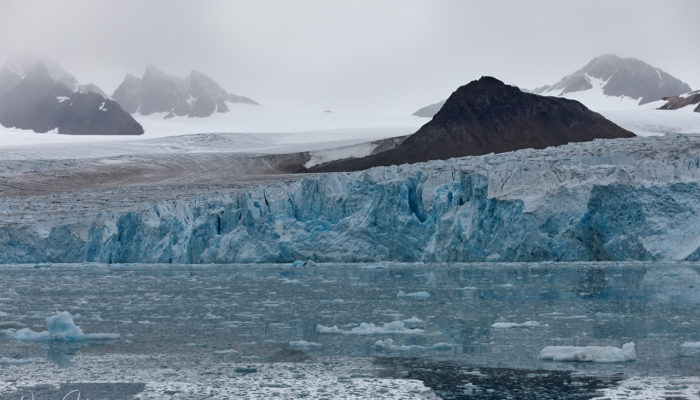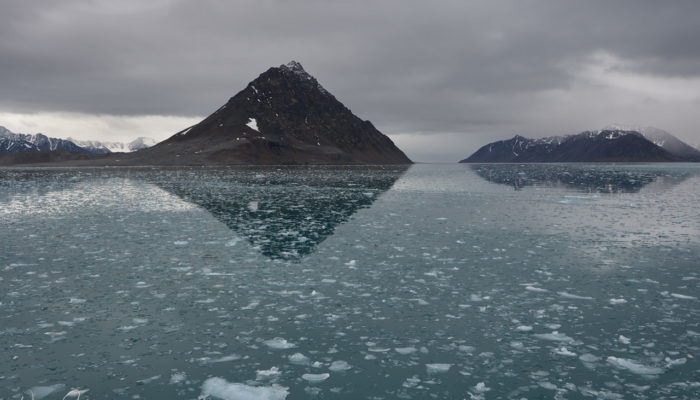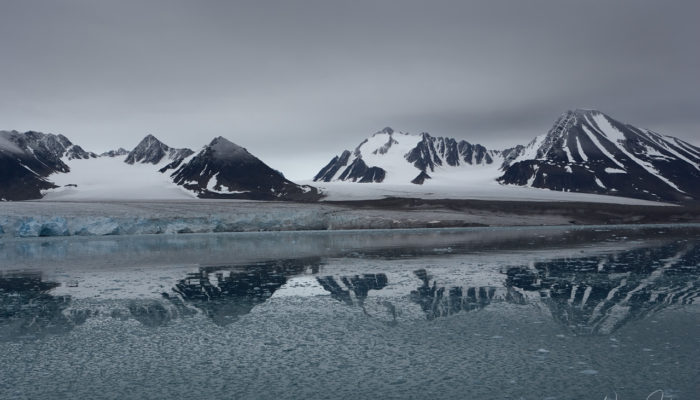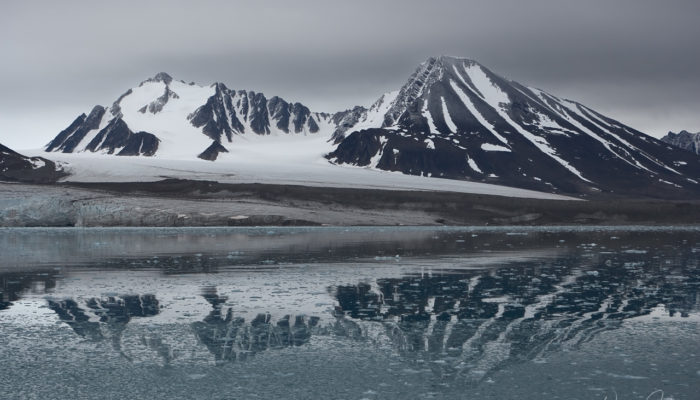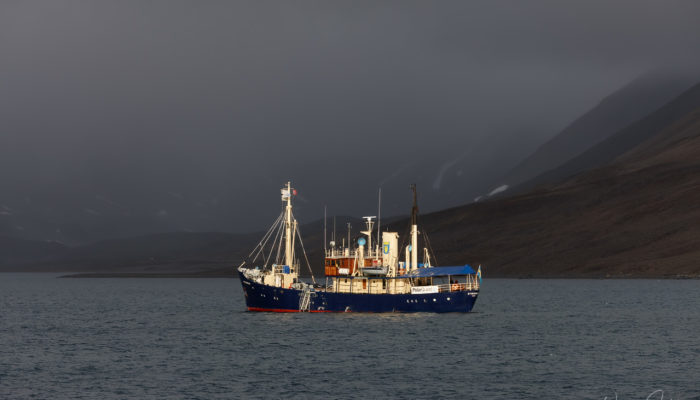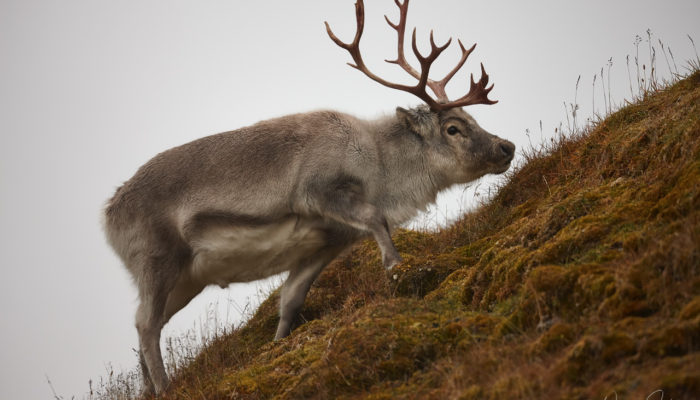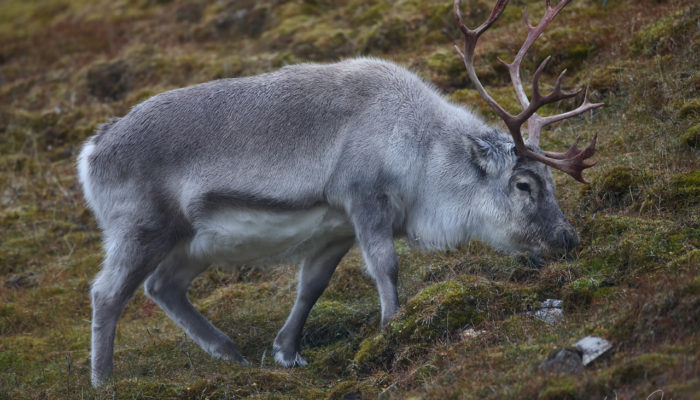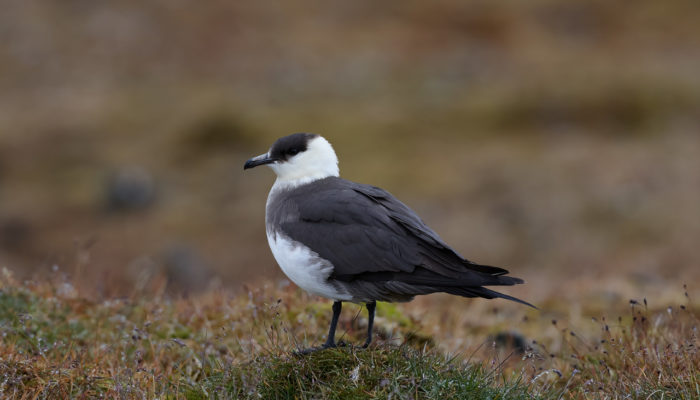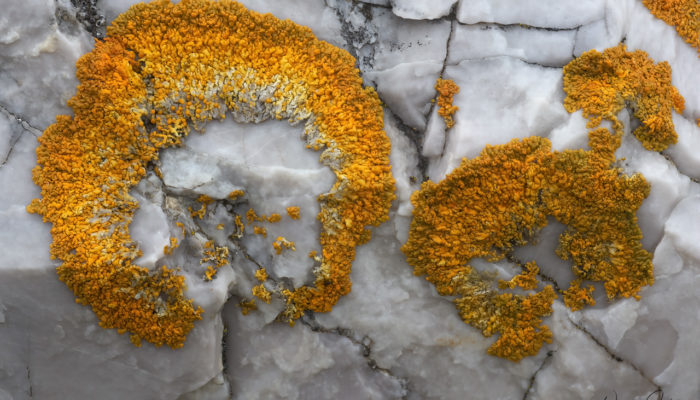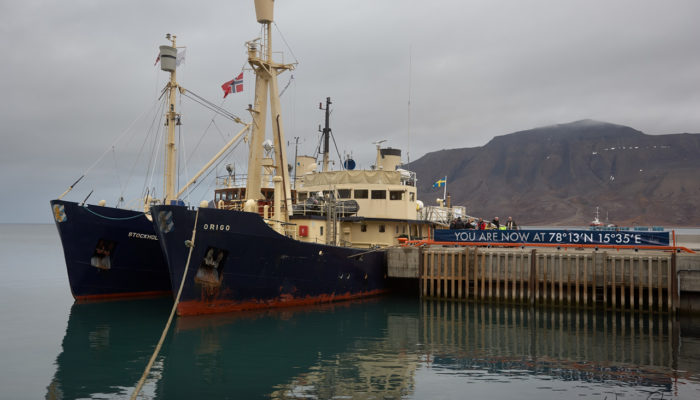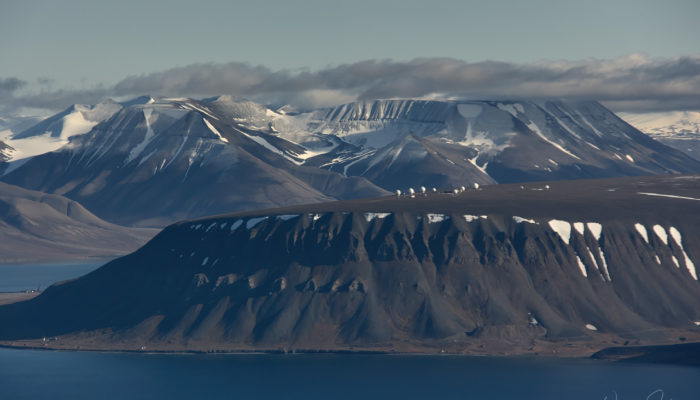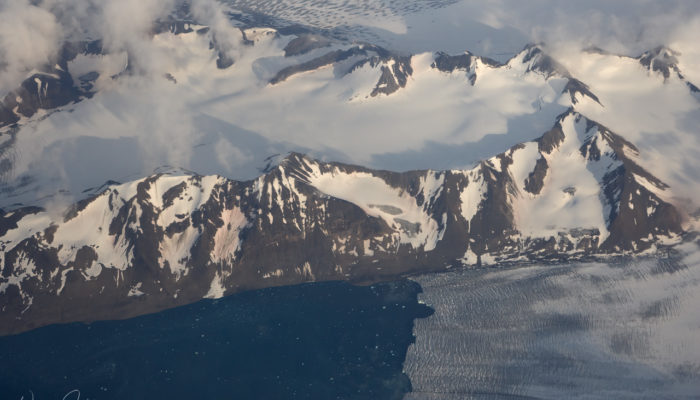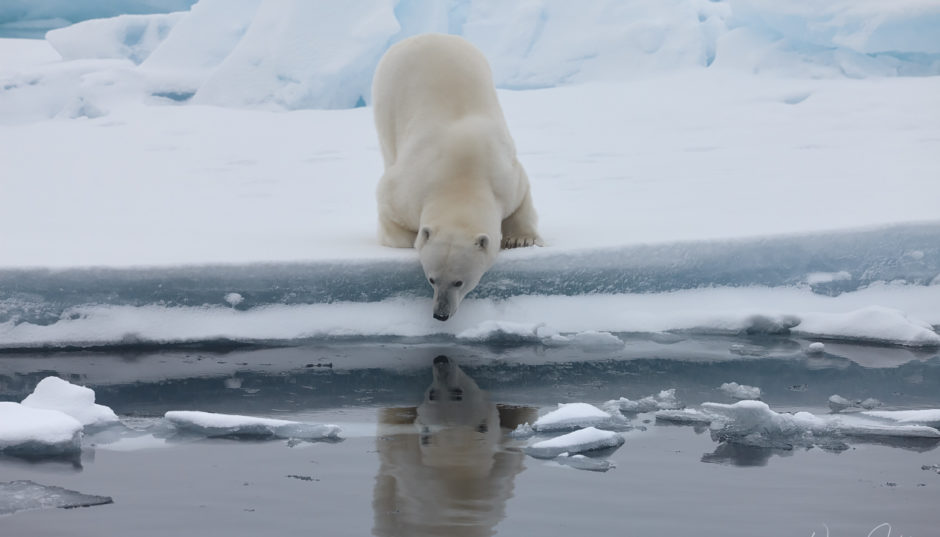
Over the last 2 decades, the Svalbard archipelago, sometimes wrongly equated with its main island Spitsbergen, has become the most popular destination for tourists and photographers, specifically in search of polar bears. Located halfway between Norway and the North Pole, no other place in the High Arctic actually still offers a comparable abundance of polar features and wildlife such as walrus, seals, artic foxes, reindeers, arctic birds some of them nesting on giant bird cliffs etc. – and polar bears being the main attraction, of course. I’ve also seen polar bears in the Canadian and Russian Arctic, but nowhere else is the chance of encountering them as high as in this comparatively limited area.
Svalbard’s landscape of peaked mountains, deep fjords with floating icebergs originating from its still large glaciers, its blooming tundra -altogether is simply stunning, especially under the midnight sun or in the soft light in spring and late summer.
For all these reasons, Svalbard is a photographer’s dream and has been one of my favorite destinations in the past 2 decades. My first visit to the archipelago dates back to 2001 when I crossed over from Tromsø aboard the old Hurtigruten ship “MS Nordsternjen”, which however could only sail along Spitsbergen’s west coast no further north than to the Magdalenefjord. So I am very glad and grateful that I was able to enjoy the unique beauty of this polar jewel more extensively for the first time in 2003 and 2004, before the consequences of climate change became blatant and mass tourism, including the conflicts described below, had not yet started to the extent it is today. Our advances into the remote pack ice, usually located further north of the archipelago, have remained an unforgettable experience. Since then, I had visited the archipelago several times, the 2008 voyage aboard MS Origo to which the gallery refers being one of them. My most recent visit took place in 2017.
Voyage 2008,- the numbers 1-11 indicate the itinerary and main points
The impact of climate change and mass tourism
On the other hand, nowhere else on earth, the impact of the global warming is as obvious and dramatic as in the Arctic, accelerating three times as fast as the global average and evident by a continuing and immense loss of sea ice and retreat of the glaciers. The much higher speed of the global warming in the Arctic mainly occurs because melting of snow and ice exposes a darker surface and increases the amount of solar energy absorbed in these areas. Over the past 50 years, the melting Arctic glaciers have raised the sea level by more than 2 cm. More than half of this increase occurred between 2005 and 2015.
Ultimately, there’s an irreversible change in the Arctic that will also affect global climate and weather patterns, and will potentially lead to the loss of the unique polar ecosystem in its entirety as we still know it today. The threat and decline of the polar bear population has just become the familiar symbol of the change.
Before the turn of the millennium, Svalbard was a lesser-known, rather exotic destination and more of an insider tip for specialists and ambitious photographers. In the early 1990s, visitors numbered 20,000 or so at maximum. And when I visited in 2003 only smaller ice-strengthened expedition vessels carrying a limited number of passengers could navigate the icy waters around Svalbard. In particular the melting and receding sea ice has changed the situation dramatically, encouraging tour operators and travel agents to promote a wide range of travel, including those on giant cruise ships that could not go there before. They transport hundreds or even thousands of tourists flooding Longyearbyen and the fragile polar environment, making Svalbard the hot spot for Arctic cruise tourism. Consequently, there’s a worrying side effect of the global warming in the Arctic, the more as tour operations in Svalbard can start two months earlier than in the past. In 2016 tourism overtook mining as the largest industry and since has become the most important economical factor in Svalbard. Anyway, the end of Norway’s coal mining has been set to September 23, 2023.
Tourism has received an enormous boost over the last two decades and has more than tripled since my visit in 2003. Though the concrete numbers somewhat differ depending on the source and method of recording, tourist visits have reached 150,000 in 2018 according to the Norwegian Institute for Nature Research (NINA), which means a more than 70 per cent increase in five years. A particular challenge is the growing cruise traffic, which reached 45,900 passengers on 15 overseas ships in the peak year of 2018 compared to just under 30,000 a decade earlier. After the ban on heavy crude oil, overseas ships have become fewer but larger with more passengers on board. Additional to the cruise liners, smaller expedition vessels carried 17 245 passengers to Svalbard in 2018. The number of those ships has increased from 23 in 2010 to 73 in 2019. Recorded passenger landings from tourist ships outside the settlements increased from 29,600 in 1996 to 124,000 in 2019. This compares to a local population of around 2,000 people living in Svalbard.
Other sources put the total number of tourists aboard the various ships at 96,498 in 2018 — the highest number before the pandemic, contributing 12 Mio USD to the economy. Considering the data, it has to be taken into account, though, that numerous visitors arrive in Longyearbyen by air with many of them embarking on ships for cruises around the archipelago or one-day trips to Pyramiden and Barentsburg. It’s worth mentioning that in the last decade the number of airline passengers increased by almost 80,000, but it is becoming impossible to estimate how many are simply tourists.
Though strict rules and guidelines have been established in Svalbard, it’s evident that the mass tourism nonetheless has an increasing impact on the vulnerable Arctic nature with hordes of cruise passengers literally leaving big footprints when they go ashore by trampling the fragile tundra vegetation that can take decades to recover. The number of landing sites has increased from 120 in 2001 to 224 in 2019. There are cumulative effects and visible degradation on sites visited by cruise ships over a number of years. Both cultural and historical remains are exposed to degradation and damage from overtourism, too. The increasing number of hikers, campers, dog sled tours and other touristic activities may also pose a threat to the fragile, previously pristine nature. That’s definitely true for 2000 snowmobiles in Svalbard and the new “Sail & Ski” activity, the more as tourism has been extended to the winter time, too.
Currently, there is a big discussion over the extent to which mass tourism, particularly from cruise ships, is disrupting and threatening birdlife and wildlife, especially polar bears, on Svalbard. Actually, wildlife viewing has become an increasingly popular activity in the tourism with polar bears at the top of the wish list. More and more people want to see exotic animals in the wild and as close up as possible, creating a demand which can be harmful to certain species. Not all operators act responsible in their conduct and compromise good practices in wildlife viewing for commercial interests, some of them even advertising and promising close encounters with the bears though it’s strictly forbidden by law to seek out, lure and pursue polar bears. According to the Governor, this summer of 2022, there will be a record number of boats conducting business on Svalbard. The first tourist boats were in place already in April, much earlier than normal while there was still a lot of ice in the fjords, which makes it easier to get close to the bears that are hunting seals along the ice edge. As of mid May 2022, around 40 tourist boats and vessels of different sizes were already in operation on Svalbard in almost all the fjord arms on the west side of Svalbard; another 40 boats were expected to reach the archipelago in the next weeks.
It’s reported that the police currently is investigating several possible violations of the Svalbard Environmental Protection Act by tour operators. That early in the first season after the Corona pandemic, it would be very sad if the suspicion of illegal activities turns out to be true, of course. Since May 2022, the debate on the impact of polar-bear focused tourism additionally has been heated by a corresponding article and photos circulating in social media, i.e. showing a polar bear standing on an ice edge close to a tourist ship. With the headline that ”polar bears are disturbed by tourists around the clock” the issue even was covered by Norway’s most important news platform NRK. However, I personally had that kind of close encounters with a polar bear several times, while the ship was parked at the ice edge. It also occurred on this 2008 trip (see photos #071 – #074 in the gallery). Being a curious animal it happens that the bear comes closer to inspect the object of curiosity once he gets aware of it. And sometimes he (or she) approaches close enough to even sniff on the hull, while the people on board are taking pictures before the bear is walking away again. So photos like the one the article refers to, are not uncommon and per se no evidence of illegal activity and harrassment of bears by tourist ships. Of course, nobody who wasn’t at the location knows the specific scenario and can definitely confirm or rule out that any bear in the immediate vicinity to a ship was actively lured or even fed. But based on the published images heating the debate there is no solid information to justify the article’s lurid headline and finger-pointing.
Nevertheless, the legislative authorities are currently considering – amongst many other things – a legal requirement to keep a general minimum distance of 500 meters from polar bears under any circumstances !! If this policy goes into effect, the ship must move away from or even deter a polar bear once the animal comes closer. Either scenario would much more likely disturb the bear and make the intended protection absurd..
In a contribution to the debate, the known conservatist and guide Morten Jørgensen criticizes the above- mentioned article and the reaction of the Norwegian officials:
“Norwegian authorities, institutions and scientists harass and endanger polar bears, while the blame is shifted onto tourism and particularly international operators”
He points out that bears repeatedly are chased by helicopter, shot at from the distance with a tranquilizer dart, then man-handled in various ways including blood sampling, biopsy sampling and tooth extraction and afterwards left lying helplessly exposed in the environment until able to recover enough. According to Morton, in April 2022 alone, Norwegian polar bear researchers distressed at least 50 live polar bears in Svalbard. He claims that numerous scientists repeatedly and excessively traumatize polar bears to maintain mostly irrelevant studies, careers, and funding. On my last trip in 2017 the majority of (female) polar bears I had encountered, actually were wearing GPS tracking collars indicating that kind of treatment. Beyond that, there are reports that the tight radio collars can injury the bears..
Morton also states, that Norway cashes in on international commercial trading in polar bear body parts and you can buy the remains of a shot polar bear in Skinboden. Allegedly, there is a store-room with 100 slaughtered polar bears in Bergen.
So the controversial and heated debate is going on. In any case the changes in the Arctic and threat of the whole ecosystem including the polar bears is a fact. Mass tourism, especially on big ships, is part of the challenge and raising concern. Recent scientific studies demand tougher regulation of tourism in the Arctic archipelago and of the cruise industry in particular. Norway’s government is already considering stricter rules for what industry players on Svalbard may and may not do. In addition, more far-reaching restrictions are being discussed, not only concerning the already mentioned distance of 500 m to polar bears, but even the closure of large parts of Svalbard to tourism.
Though all our voyages around Svalbard were fascinating and each of them had offered special highlights and experiences, the continuing and sad changes in the Arctic due to the global warming could not be overlooked and denied over time, especially striking if we had revisited identical places.The growth of tourism was also evident. While we only met a handful of people in Longyearbyen in 2001 respectively 2003, there were hundreds in the streets and coffees by 2017 coming from a big cruise ship anchoring there.
The trip aboard M/S Origo
The gallery below displays a small selection of my images taken in 2008 on the voyage around Spitsbergen onboard the small ship MS Origo carrying only 26 passengers. The tour was specifically designed for photographers and two professional TV teams. We had 6 encounters with polar bears, two of them particularily memorable with a young bear closely approaching the ship anchoring in the pack ice and the sighting of another older male that evidentally had well recovered from a walrus attack, indicated by two healed wounds from walrus tusks on his back – quite a rare observation. (see photos #027- #032). As shown in the gallery, we also photographed walrus, seals, reindeers and more. The map above can give a rough impression of the travel route. It was a great trip despite the often foggy and overcast sky on most of the 9 days but with some beautiful sceneries in the late summer light, too. In 2009 I had joined a second Svalbard voyage onboard MS Origo. The images will be shown in a separate gallery.
Photography
The photographs of wildlife mostly were captured with the Canon 600mm/f4 L IS and 300mm/f 2.8 L IS Tele lenses, some included the 1,4x II and 2.0x II Extenders mounted on Canon 1D Mark III, 1Ds Mark II or 1 Ds Mark III cameras. For landscapes I had used the Canon 24-105mm/f4 L IS, 28-70mm/2.8, 70-200mm/f4 L IS, 70-200mm/f 2.8 L IS zooms and occasionally the 14mm/f2.8 L super wide angle lens, too.

